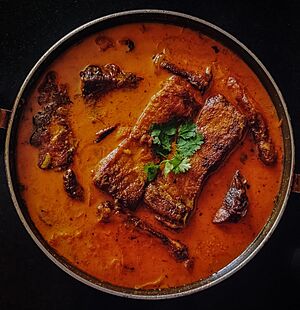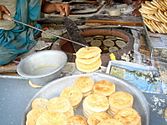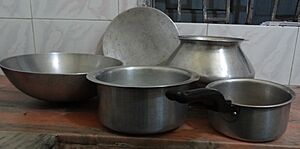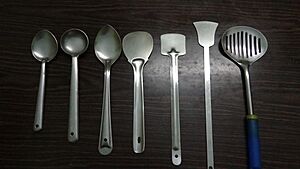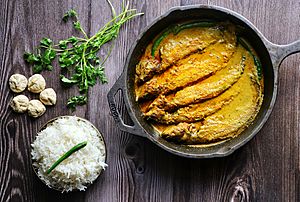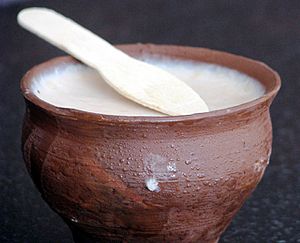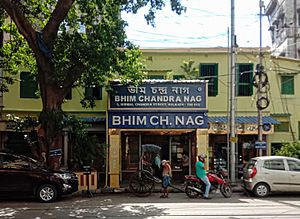Bengali cuisine facts for kids
Bengali cuisine is the yummy food style from Bengal, a region in the eastern part of the Indian subcontinent. This area includes Bangladesh and parts of India like West Bengal, Tripura, and Assam's Barak Valley. The food here has been shaped by a long and interesting history and different weather conditions. It's famous for using many different flavours and for its amazing sweets and desserts.
Unlike many other South Asian foods, Bengali meals are often served in different parts, like courses in a fancy French dinner. This means you get one type of food, then another, instead of everything at once. Rice is super important and is usually eaten with fish, meat, vegetables, and lentils. Many Bengali food traditions come from social gatherings, like adda (a friendly chat) or big feasts called Mezban.
Contents
How Bengali Food Was Shaped
Mughal Empire's Influence
Around the mid-1200s, Muslims came to Bengal. They brought their own delicious Persian and Arabic cooking styles. Dishes like biryani, korma, and bhuna were once only for kings and queens. But Mughal cooks shared their recipes with everyone.
This influence grew even more when the British Raj ruled. Many important leaders, like Tipu Sultan's family and Wajid Ali Shah, came to live in Kolkata. They brought hundreds of cooks and spice mixers with them. As these royal families lost their money, their cooks started working for local people. These cooks knew how to use many different spices, like saffron and mace. They also used lots of ghee (clarified butter) and marinated meat with yogurt and chili.
In Bangladesh, these Mughal-inspired foods are now very common. In West Bengal, they are still often made by professional chefs. New dishes were also created, like chap (ribs cooked slowly on a flat pan) and rezala (meat in a thin yogurt and cardamom sauce). Kathi rolls (kebabs wrapped in bread) also became popular.
The Mughals really loved meat. They made mutton and beef popular in Bengali cooking. Before, people mostly ate chicken and venison.
Traditional Bengali desserts used to be made from rice paste and jaggery (a type of unrefined sugar). But with Mughal influence, desserts started using more milk, cream, and sugar. They also added expensive spices like cardamom and saffron.
Widows' Cooking Style
In old Hindu traditions, widows were not allowed to eat certain foods. They couldn't eat "heating" foods like shallots and garlic, but ginger was okay. They also couldn't eat meat or fish.
This meant widows had to be very creative with vegetables and cheaper spices. They developed a unique cooking style that became a big part of Bengali curries, both vegetarian and non-vegetarian. Expensive spices like saffron or cinnamon were rarely used. Nuts, dried fruits, milk, and milk products were also scarce. These rules led to many new and tasty vegetable-based meals.
Bengal's Division Changes Food
When Bengal was divided into India and Bangladesh, many people moved. This led to changes in how people ate, especially to follow religious rules. In Bangladesh (which was once East Bengal and East Pakistan), Mughlai food is very common. This includes foods like beef kebabs, which are less popular in West Bengal. Sweets like zarda and firni-payesh are also eaten.
In West Bengal, the only food restriction is beef, but only for Hindus. During the time of British rule, many Western food shops opened in Kolkata. This made puff pastries, chocolate, and chips very popular. Dishes like chop, gravy cutlet, spongy rosogolla, and ledikeni also became favorites. Kolkata's food keeps changing because of its many different cultures, including strong influences from Chinese and Marwari communities.
What Makes Bengali Food Special
Bengali food can be divided into four main types:
- Charbya (Bengali: চর্ব্য): Food that is chewed, like rice or fish.
- Choṣya (Bengali: চোষ্য): Food that is sucked, like sour dishes called ambal and tak.
- Lehya (Bengali: লেহ্য): Foods that are licked, like chutney.
- Peya (Bengali: পেয়): Drinks, mainly milk.
Regional Specialties
Different parts of Bengal are famous for certain dishes and ingredients. For example, southern Bengal, near the Sundarbans, uses an expensive chili called chui jhal. They peel and chop it into small pieces to add a strong smell and taste to their dishes.
North Bengal is known for many Bengali desserts. These include the Mishti doi (sweet yogurt) from Bogra, the Kachagolla from Natore, and the Chomchom from Porabari. Other regions also have famous sweets. Netrokona has the Balish Mishti (pillow-sweet). Muktagachha has the Monda. Nabadwip has the Red Yoghurt. And Comilla is famous for its Roshmolai.
Chittagong's Food
Chittagong's food is mostly known for Mezban feasts and mixed rice dishes. One famous dish is kala bhuna, made with beef shoulder pieces and traditional spices. Dried fish (shutki) is also more common in Chittagong than in other parts of Bengal.
Mezban Feasts
Mezban (also called Mejjan) is a special feast in the Chittagong region of Bangladesh. It's a traditional meal where people are invited to eat white rice and beef, along with other rich dishes. Mezban feasts are held for special events. These include death anniversaries, birth anniversaries, celebrating successes, starting a new business, moving into a new house, the birth of a child, weddings, and naming ceremonies.
Anyone can usually come to a Mezban feast. In cities, you might need an invitation. People usually eat from morning until afternoon. Beef dishes are very popular for Mezban feasts among Bengali Muslims. They show how important the event is. Rich and poor families arrange these feasts when they can. Cooking Mezban meat needs special skills. The unique beef curry served at these feasts is called Mezbani gosht. Only Chittagong cooks usually know its special recipe.
When Hindus in Chittagong have a Mezban, they use fish instead of beef. The Hindu community in Chittagong holds a Mezban every year. They serve curries made from fish, vegetables, and dried fish.
Dhaka's Special Dishes
Dhakaiya food is one of the most famous regional cuisines. Its rich cooking traditions are influenced by Mughlai, Central Asian, Armenian, Hindustani, and local Bengali foods. But Dhaka also has its own unique dishes.
The Nawabs of Dhaka brought Mughlai cuisine to Bengal. Dhaka's cooks kept these traditions alive. Because Mughlai food was expensive, only rich people ate it in old India. As Bangladesh's economy grew, more people could enjoy it. Dhakaiya food focuses on lamb, mutton, beef, yogurt, and mild spices.
Dishes like kebab, stuffed breads, kacchi biriyani, roasted lamb, duck, and chicken, patisapta, Kashmiri tea, and korma are still served at special events like Eid and weddings. Since this food was for the upper class, using lots of expensive ingredients like ghee was important. The goal was to make the food melt in your mouth.
Old Dhaka has a special type of pilaf called Morog Polao. In this dish, the rice is cooked after the chicken pieces are cut. Other polaos include ilish polao (with hilsa fish) and rui polao (with rohu fish). Dhakaiyas are known for adding paneer (Indian cheese) and boiled eggs to khichuri (a rice and lentil dish).
Dhakai bakarkhani is a thick, biscuit-like flat-bread. It's a traditional street snack, famous for its taste. It's usually eaten with tea. Dhakaiyas are proud of making the best khili paan (a special betel leaf wrap) using different herbs and spices. They even have a khili paan for people with diabetes.
Haji biryani is a famous dish created by a restaurant owner in 1939. It's made with very flavorful rice, goat's meat, and many spices and nuts. This restaurant has become a big part of Dhakaiya culture.
Kolkata's Food Scene
In Kolkata, many street vendors have small shops where they sell homemade foods. Items like cheeses (paneer) can be eaten plain. They can also be made into sweet sandesh, rosogolla, or chanar payesh. Milk is used a lot in Kolkata's different types of payesh (rice pudding). These vary with different grains and additions like dates, figs, and berries.
Besides European foods like chocolate, Kolkata's cooking also gets ideas from its Chinese community. Phuchka, also known as panipuri in other parts of India, is a common Bengali street food. It's made with a fried dough shell and a potato and chickpea filling. You can usually find it at small stalls next to bhelpuri, masala chai, ghugni, and chaat stalls.
Outside Influences on Kolkata Food
In the 1800s, many Odia cooks moved to Bengal. They worked in the homes of rich Kolkata families. They also cooked for weddings and other family events. When Odia cooks came into Kolkata kitchens, they brought small but important changes to the food. Many classic Kolkata dishes were first from Odisha. But they were made even better in Kolkata kitchens by Odia cooks. Some say that dishes like kanika (Bengali mishti pulao) were first brought to Kolkata by Odia cooks. Even today, most cooks in Kolkata kitchens and hotels are Odia.
The Chinese of Kolkata first settled in a village called Achipur in the late 1700s. Later, they moved into the city and then to Tangra on the eastern edge of Kolkata. The Chinese people in Kolkata are a large and successful community with their own identity. With this identity came Chinese food. Now, you can find Chinese food almost everywhere in Kolkata. People love it because it tastes good, cooks fast, and is different from original Chinese recipes (except for using soy sauce). Most of these were Cantonese traders and sailors. They settled here and cooked with whatever ingredients they had.
Calcuttan immigrants have also taken this food style to other countries. Indian Chinese restaurants have opened in many places in the United States and the UK.
Indian Chinese food became even more popular in the 1950s. This was when many Tibetans moved to India after the 14th Dalai Lama left Tibet. Tibetans added their own tastes to the food. They brought popular dishes like momo (a type of dumpling) and thukpa (a hearty noodle soup). Tibetans and Nepali immigrants easily found jobs in the many kitchens now found on almost every street in Kolkata.
Adda: Socializing with Food
Adda (Bengali: আড্ডা) is a traditional Bengali way of socializing over food during the day. The food eaten during adda usually includes mishti (sweets), tea, and coffee. Sometimes, heartier foods like fried fish are also served.
Adda became very popular during the British colonial period among the Bhadralok (gentlefolk). They would meet and talk about many different topics. For example, you could be talking about a royal wedding one moment, then switch to a cricket game, and then discuss a recent controversy about a famous poet.
Adda was mostly a hobby for men. Women were largely kept out of it. But this is changing now as adda becomes more open and women play a bigger role in social life. Adda was seen as a place to escape from home and work. It was a neutral meeting spot away from daily chores and work stress.
After the colonial period, adda has been fading. This is because work schedules are stricter now, and people see too much relaxation as lazy. But many Bengalis believe adda is important for lyadh. Lyadh means doing nothing to relax and recharge. Adda still happens during vacations or after work at clubs or coffee shops. This tradition is even like the Greek symposium. Students might meet for a study session over food, or a teacher might teach in a more relaxed setting.
Sylhet's Unique Flavors
Sylhet has its own version of the famous pilaf dish called Akhni. In this dish, the rice is cooked after the chicken pieces are cut. Common meats eaten here include beef, chicken, mutton, and duck or goose. Dishes like Hash O Bash (duck bamboo curry) are popular. Sylhet is also proud of Beef Hatkora. This is a rice dish made with a wild citrus fruit not found in other parts of Bengal.
During the British rule, biscuits and loaves of bread became popular in Sylhet, especially among Muslims. However, middle-class Hindus in Cachar and Sylhet were very suspicious of biscuits and bread. They thought Muslims baked them. Once, some Hindus in Cachar saw an Englishman eating biscuits with tea, which caused a big fuss. This news reached Hindus in Sylhet, and a small rebellion happened.
In response, companies started advertising their bread as "machine-made" and "untouched by (Muslim) hand." This was to tell Hindus that the breads were "safe to eat." This event is mentioned in Bipin Chandra Pal's autobiography. He wrote about how Hindus' eating habits slowly changed over time.
-
Srimangal is famous for Seven Color Tea.
-
Chicken tikka masala was said to have been invented by a British-Bengali chef from Sylhet.
Cooking Tools
Bengali food is often served on plates with a special flowery design, usually in blue or pink. Another unique thing about Bengali cooking is the boti. This is a long, curved blade on a platform that you hold down with your feet. You use both hands to hold what you're cutting and move it against the blade, which faces you. This tool gives you great control and can cut anything from small prawns to big pumpkins.
A korai is a cooking pot used for most Bengali sauces and stir-fries. The dekchi (a flat-bottomed pan) is usually for cooking larger amounts or for making rice. It has a thin, flat lid that also helps drain out starch when cooking rice. The tawa is used to make roti and paratha (flatbreads). Another important cooking pot is a hari, which is round at the bottom. All these pots come in different sizes and are made from various metals.
A flat metal spatula called a khunti is often used. Other tools include the hata (a scoop with a long handle), jhanjri (a round, sieve-like spatula for deep-frying), the shanrashi (pincers to take pots off the fire), and the ghuntni (a wooden hand blender for mashing lentils). There's also the wooden belun chaki (a round board and rolling pin for dough) and the shil nora, which is like a mortar and pestle for grinding spices. The kuruni is only used to grate coconuts.
Traditional Bengali cooking does not use silverware.
Eating Habits
A typical Bengali meal follows a certain order, similar to courses in Western dining. There are two main sequences: one for special dinners like weddings and one for everyday meals.
How Meals Were Eaten in the Past
Bengalis usually ate sitting on the floor. Food was served on a dostorkhan (a cloth spread on the floor). Historically, they ate without silverware. A large banana or plantain leaf was used as a plate. Sometimes, plates were made from dried sal leaves sewn together.
It was polite to offer guests food and drink based on when they visited. At meals, guests were served first. The only exceptions might be very old or very young family members. Within the family, the oldest males or those with the highest social rank were served first. School-age children were served before wives, daughters-in-law, and the cook, who ate last.
How Meals Are Eaten Today
Before British rule, following the meal order showed your social status. But with British and Portuguese influence, and more middle-class families, this has slowly changed. Courses are often skipped or combined in everyday meals. Meals used to be served course by course by the youngest women in the house. But now, with more nuclear families and city living, this has changed.
It's common to put all the food platters in the middle of the table. Each person then serves themselves. Special events like weddings used to have very detailed serving rituals. But now, professional catering and buffet-style dining are common. However, big family gatherings and very fancy feasts might still follow the old rules.
Daily Meals
Daily meals are usually simple. They focus on good nutrition and use lots of vegetables. The courses generally go from lighter foods to richer, heavier ones. They also include different tastes and palate cleansers. Rice is eaten throughout the meal and is the main part of the meal until the chaţni (chutney) course.
Main Dishes
Fish Dishes

Bengalis eat a lot of fish. They usually look for freshwater fish when cooking. They also add a special spice mix called phoron. Popular fish curries include boal, rohu, ilish, and pabda.
One tradition is to cook the left side of the cidal fish in oil.
Sweets
Bengali sweets have a long history. A Portuguese traveler in the 1600s saw many milk-based foods and sweets made in traditional ways. Falooda, shahi jilapi, and shemai are popular sweet foods and desserts.
Roshogolla
Roshogolla, a traditional Bengali sweet, is one of the most eaten sweets in India. It became popular in Bengal in 1868. Sweets made from chhana (fresh cheese) started appearing in Eastern India around the 1700s. The way to make chhana was brought to India by the Dutch in the 1790s.
The first versions of Roshogolla didn't hold their shape well. This was because people didn't know how to make chhana that would bind together. Nobin Chandra Das later developed the spongy version of Roshogolla that is famous today. He and his family kept improving it. The chhana used back then was rough and crumbly. It was made using acids from natural fruits. This kind of chhana couldn't be shaped into firm sweets. But later, lactic acid (from whey) was brought to India by Dutch and Portuguese colonists. This method creates the smooth, fine chhana used today, which holds its shape well. This is now the main ingredient for Bengali sweet makers.
Darbesh
Laddu (called darbesh in Bengal) is a very common sweet in West Bengal and Bangladesh. It's also popular across the Indian subcontinent, especially during celebrations. They are usually made from flour, ghee (clarified butter) or oil, and sugar. Other recipes can use coconut shavings, jaggery, raisins, chopped nuts, oatmeal, khoa (dried milk solids), nutmeg, cardamom, or poppy seeds. This sweet has been around since 4 BCE, when it was used for medicine.
Pantua
Pantua is similar to gulab jamun. You could call it a Bengali version of that dish.
Other Sweets
Several types of doi (yogurt) are popular in West Bengal. These include mishţi doi (sweet yogurt) and fruit-flavored doi like aam doi (mango yogurt). Custards and rice pudding (khir or firni) are also loved.
Other examples of Bengali sweets include Shôndesh, chhanar jilapi, kalo jam, raghobshai, jolbhora shondesh, roshbhora, lord chomchom, payesh, bundiya, nalengurer shôndesh, malpoa, shor bhaja, langcha, and babarsa.
Drinks
Common drinks include shorbot, lachhi, ghol, matha, falooda, and Rooh Afza. The two main types of Bengali tea are dudh cha (milk tea) and masala cha. Srimangal, known as the tea capital of Bengal, is famous for its Seven Color Tea. Dhaka is famous for borhani.
Traditional fruit juices (rosh) are also popular. These include sugarcane juice, mango juice, palm fruit juice, and date juice. Drinks made with basil seed or tukma are also enjoyed.
Gallery



